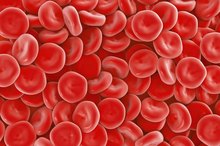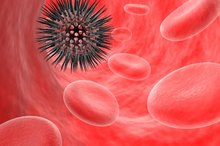Causes of Low HCT and HGB
HCT and HGB are extremely common blood tests, which are usually measured together. HCT -- short for hematocrit -- is the volume of red blood cells (RBCs) within a specific volume of blood. HGB -- or hemoglobin -- is the amount of HGB in a specific volume of blood. As HGB is the oxygen-carrying protein within RBCs, the HCT and HGB are closely linked. When one falls, the other generally falls as well. Both HCT and HGB provide approximations of the number of RBCs contained in the blood, and low values indicate the presence of anemia.
Low HCT and HGB may be caused by a reduced total number of RBCs or by excessive fluid within the blood, which dilutes the RBCs. The number of RBCs may be reduced by blood loss, impaired RBC production or excessive RBC destruction.
Blood Loss
Bleeding is one of the most common causes of low HCT and HGB. The blood loss may be obvious, such as from an acute traumatic injury. Acute blood loss may also be hidden, as in rupture of an aortic aneurysm -- a distended area of the large artery extending from the heart into the abdomen.
Chronic blood loss may likewise be visible, as in excessive menstrual bleeding, or it may be hidden.
Bleeding from the gastrointestinal tract over a prolonged period of time is a common cause of anemia that often goes unrecognized.
Ulcers and cancers of the esophagus, stomach or intestines are some of the most serious causes of chronic gastrointestinal blood loss. In adults with a low HCT and HGB for no apparent reason, a stool sample is often tested for blood.
- Bleeding is one of the most common causes of low HCT and HGB.
- Bleeding from the gastrointestinal tract over a prolonged period of time is a common cause of anemia that often goes unrecognized.
Reduced Red Blood Cell Production
Polychromasia Causes
Learn More
RBCs are produced in the bone marrow, so any disease within the marrow may cause anemia, depending on the extent of bone marrow affected. In aplastic anemia, for example, the entire bone marrow stops producing RBCs and anemia may be severe. Infiltration of the bone marrow by fibrous tissue or cancer cells likewise interferes with RBC production. As normal RBC production requires iron, folate, vitamin B6 and vitamin B12, deficiency of any of these nutrients can produce a low HCT and HGB.
In some diseases, such as sideroblastic anemia, iron levels are normal but the bone marrow is unable to effectively use the iron. Drugs that interfere with folate metabolism, such as anti-HIV or anti-seizure medications, can likewise reduce RBC production.
Adequate RBC production also relies on erythropoietin, a hormone made by the kidneys.
In severe kidney disease, impaired erythropoietin production reduces the number of RBCs. Liver disease, an overactive or underactive thyroid, and many chronic inflammatory diseases -- such as rheumatoid arthritis -- may also be associated with reduced RBC production.
- RBCs are produced in the bone marrow, so any disease within the marrow may cause anemia, depending on the extent of bone marrow affected.
- In severe kidney disease, impaired erythropoietin production reduces the number of RBCs.
Increased Red Blood Cell Destruction
A certain amount of RBC destruction, or hemolysis, is normal. RBCs remain in the bloodstream for about 120 days, after which they are destroyed -- primarily in the spleen -- and replaced by new RBCs released from the bone marrow.
Hemolytic anemia develops when RBC destruction occurs before this time and the bone marrow is unable to release enough new cells. In diseases with abnormally shaped RBCs, such as sickle cell anemia or spherocytosis, the body identifies the cells as abnormal and destroys them prematurely. In glucose-6-phosphate dehydrogenase (G6PD) deficiency, RBCs are unusually susceptible to harmful oxidizing molecules. This leads to hemolysis during acute illnesses, such as infections, or upon exposure to fava beans or certain drugs.
Hemolysis may also be caused by disorders outside RBCs. In hypersplenism, the spleen is overactive and destroys an excessive number of RBCs.
In some autoimmune diseases, hemolysis occurs when the body makes antibodies that attack its own RBCs. Certain bacteria, such as meningococci and streptococci, produce toxins that directly destroy RBCs. Hemolysis may likewise result from direct trauma to RBCs as blood flows through artificial heart valves or past blood clots within blood vessels.
- A certain amount of RBC destruction, or hemolysis, is normal.
- In some autoimmune diseases, hemolysis occurs when the body makes antibodies that attack its own RBCs.
Increased Plasma Volume
Diseases That Cause Low Red Blood Count
Learn More
Sometimes, the HCT and HGB are low solely because the fluid component of blood -- known as the plasma -- is increased. In these instances, the total number of RBCs in the body is normal, but the cells are diluted so the number of RBCs in a specific volume of blood is decreased. An increased plasma volume occurs in disorders characterized by fluid retention, such as severe kidney disease or congestive heart failure.
The fall in HCT and HGB seen during a normal pregnancy is also caused by increased plasma volume. RBC production increases during pregnancy, but the increased number of RBCs is insufficient to keep up with the increase in plasma. Excessive water drinking will not usually cause a fall in HCT or HGB, but excessive administration of intravenous fluids might.
- Sometimes, the HCT and HGB are low solely because the fluid component of blood -- known as the plasma -- is increased.
- Excessive water drinking will not usually cause a fall in HCT or HGB, but excessive administration of intravenous fluids might.
Warnings
A low HCT and HGB always require followup with your doctor to determine the cause and appropriate treatment.
While mild anemia generally produces minimal effects except pale skin and fatigue, a very low HCT and HGB can be life-threatening as it limits the delivery of oxygen to vital organs of the body. Seek immediate medical attention if you have significant bleeding or symptoms of inadequate oxygen delivery to the heart or brain, such as chest pain, shortness of breath, lightheadedness, weakness or a decreased level of consciousness.
Reviewed by: Tina M. St. John, M.D.
- A low HCT and HGB always require followup with your doctor to determine the cause and appropriate treatment.
- While mild anemia generally produces minimal effects except pale skin and fatigue, a very low HCT and HGB can be life-threatening as it limits the delivery of oxygen to vital organs of the body.
Related Articles
References
- Cleveland Clinic Center for Continuing Education: Anemia
- Merck Manual Professional Version: Sideroblastic Anemias
- Merck Manual Professional Version: Overview of Hemolytic Anemia
- American Family Physician: Normocytic Anemia
- The Lancet: Glucose-6-phosphate Dehydrogenase Deficiency
- Merck Manual Professional Version: Physiology of Pregnancy
- Jankowska EA, Tkaczyszyn M, Drozd M, Ponikowski P. Monitoring of iron status in patients with heart failure. Eur Heart J Suppl. 2019;21(Suppl M):M32-M35. doi:10.1093/eurheartj/suz231
- Ahmed P, Chaudhry QUN, Satti TM, et al. Epidemiology of aplastic anemia: a study of 1324 cases. Hematology. 2020;25(1):48-54. doi:10.1080/16078454.2019.1711344
- Stauder R, Valent P, Theurl I. Anemia at older age: etiologies, clinical implications, and management. Blood. 2018;131(5):505-514. doi:10.1182/blood-2017-07-746446
- Wirth JP, Woodruff BA, Engle-stone R, et al. Predictors of anemia in women of reproductive age: Biomarkers reflecting inflammation and nutritional determinants of anemia (BRINDA) project. Am J Clin Nutr. 2017;106(Suppl 1):416S-427S. doi:10.3945/ajcn.116.143073
- Ford ND, Bichha RP, Parajuli KR, et al. Age, ethnicity, glucose-6-Phosphate dehydrogenase deficiency, micronutrient powder intake, and biomarkers of micronutrient status, infection, and inflammation are associated with anemia among children 6-59 months in Nepal. J Nutr. 2019;Dec28. doi.10.1093/jn/nxz307
- American Society of Hematology. Common types of anemia.
- Powell DJ, Achebe MO. Anemia for the primary care physician. Prim Care. 2016;43(4):527-542. doi:10.1016/j.pop.2016.07.006
Writer Bio
Based in Houston, Texas, Dr. Mary D. Daley has been writing and editing health and medicine articles for more than 20 years. Daley holds an MD degree, as well as an MS in immunology and MS in biomedical writing. She is board-certified as an anesthesiologist in the United States and Canada.








